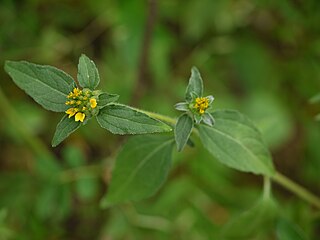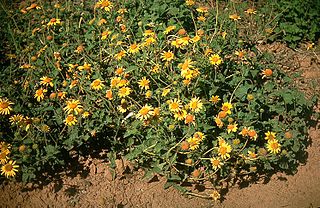
The Heliantheae are the third-largest tribe in the sunflower family (Asteraceae). With some 190 genera and nearly 2500 recognized species, only the tribes Senecioneae and Astereae are larger. The name is derived from the genus Helianthus, which is Greek for sun flower. Most genera and species are found in North America and South America. A few genera are pantropical.

Tageteae is a tribe of the plant family Asteraceae. It consists of approximately 260 species divided among 32 genera. All are found in the New World, with a center of diversity in the Mexican highlands. The type genus is Tagetes (marigolds).

Acmella is a genus of plants in the family Asteraceae, described as a genus in 1807. It is native to the Americas and has been introduced to Asia, Africa, the Pacific islands, and Australia.
Pappobolus is a genus of flowering plant in the family Asteraceae native to the Andes Mountains of Colombia, Ecuador, and Peru.

Tithonia is a genus of flowering plants in the tribe Heliantheae within the family Asteraceae.

Salmea is a genus of plants in the tribe Heliantheae within the family Asteraceae.

Sclerocarpus is a genus of flowering plants in the tribe Heliantheae within the family Asteraceae. Bonebract is a common name for plants in this genus.
Selloa is a genus of Latin American plants in the tribe Millerieae within the family Asteraceae.

Simsia is a genus of flowering plants in the tribe Heliantheae within the family Asteraceae. It includes annuals, herbaceous perennials, and shrubs. They range from the western United States south through Central and South America to Argentina, with the center of diversity occurring in Mexico. The genus is named for British physician and botanist John Sims (1749–1831). Although some species are relatively rare, others have become common weeds that line the roadsides and fields of Mexico, often forming dense stands mixed with Tithonia and other Asteraceae. Some species are known by the common name bushsunflower.
Otopappus is a genus of flowering plants in the tribe Heliantheae within the family Asteraceae, primarily Mesoamerican but with one species from Jamaica.

Oyedaea is a genus of South American flowering plants in the tribe Heliantheae within the family Asteraceae.
Stuessya is a genus of Mexican plants in the tribe Heliantheae within the family Asteraceae.
Squamopappus is a genus of Mesoamerican plants in the tribe Heliantheae within the family Asteraceae.
Rhysolepis was a genus of Mexican plants in the tribe Heliantheae within the family Asteraceae. Until 2011, when botanists Schilling & Panero studied the subtribe Helianthinae based on molecular sequences of nuclear ITS, ETS, and cpDNA, coming to a conclusion that that the genus ViguieraKunth, did not constitute a monophyletic group. Among their conclusions they proposed to reclassify the genus, dividing and relocating its species in at least eleven genera: AldamaLa Llave, BahiopsisKellogg, Calanticaria(B.L. Rob. & Greenm.) E.E. Schill. & Panero, DavilanthusE.E. Schill. & Panero, DendroviguieraE.E. Schill. & Panero, GonzaleziaE.E. Schill. & Panero, HeiseriaE.E. Schill. & Panero, HeliomerisNutt., HymenostephiumBenth., SidneyaE.E. Schill. & Panero and ViguieraKunth.
Philactis is a genus of Mexican plants in the tribe Heliantheae within the family Asteraceae.

Podachaenium is a genus of Mesoamerican plants in the tribe Heliantheae within the family Asteraceae.

Acmella oleracea is a species of flowering herb in the family Asteraceae. Common names include toothache plant, Szechuan buttons, paracress, jambu, buzz buttons, tingflowers and electric daisy. Its native distribution is unclear, but it is likely derived from a Brazilian Acmella species. A small, erect plant, it grows quickly and bears gold and red inflorescences. It is frost-sensitive but perennial in warmer climates.
Acmella pusilla, the dwarf spotflower, is a species of flowering herb in the family Asteraceae. The plant is native to South America and is naturalized in the southeastern United States.

Acmella repens is a North American species of flowering plants in the family Asteraceae. The plant is native to the southeastern and south-central United States, primarily in the coastal plain from Texas to North Carolina and in the lower Mississippi Valley from Missouri to Louisiana. There are additional populations in Coahuila in northeastern Mexico.
Acmella pilosa, the hairy spotflower, is a Mesoamerican species of flowering plants in the family Asteraceae. It is native to Guatemala, Belize, and southeastern Mexico. The species is also naturalized in the southern part of the US State of Florida.










